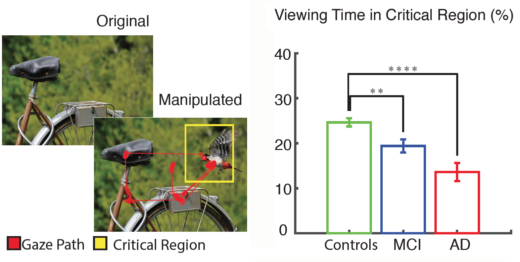Emory Brain Health researchers have developed a computer program that passively assesses visual memory. An infrared eye tracker monitors eye movements, while the person being tested views a series of photos.
This approach, relatively unstrenuous for those whose memory is being assessed, is an alternative for the diagnosis of mild cognitive impairment or Alzheimer’s disease. It detects degeneration of the regions of the brain that govern visual memory (entorhinal cortex/hippocampus), which are some of the earliest to deteriorate.
The approach was published in Learning and Memory last year, but bioinformatics chair Gari Clifford discussed the project at a recent talk, and we felt it deserved more attention. First author Rafi Haque is a MD/PhD student in the Neuroscience program, with neurology chair/Goizueta ADRC director Allan Levey as senior author.

Eye tracking of people with MCI and Alzheimer’s shows they spend less time checking the new or missing element in the critical region of the photo, compared with healthy controls. Adapted from Haque et al 2019.
The entire test takes around 4 minutes on a standard 24 inch monitor (a follow-up publication on an iPad version is in the pipeline). Photos are presented twice a few minutes apart, and the second time, part of the photo is missing or new – see diagram above. Difficulty can be modulated easily. In comparison, verbal memory tests are more complicated to administer and sometimes more frustrating for participants. The researchers write:
Anecdotally, the paradigm appears to be strikingly less distressing and frustrating to both research participants and clinical patient populations than traditional neuropsychological tasks and also avoids issues related to task comprehension and explicit memory judgments.
Study participants came from the Emory Healthy Brain Study and the ADRC: in all cases, people who had detailed clinical evaluations. The groups were not all exactly the same average age — there were 182 controls (average age 64), 74 with MCI (average age 71), and 40 with AD (average age 74):
MCI was defined by impaired memory (single or multiple domain, based on cognitive testing) with preserved functional abilities, while AD was defined as impairment in two or more cognitive domains and functional abilities.
The authors note that a subset of apparently healthy study participants had impaired memory performance. They look ahead to side by side comparisons with traditional verbal memory tests, and longitudinal studies tracking the same individuals over time. The project extends previous eye-tracking work by Stuart Zola and colleagues.

